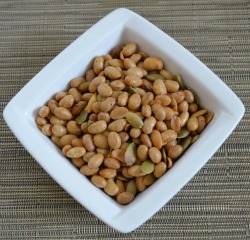Soy Allergy ABC
Soy (aka soya beans) allergy is on the rise. Most soy allergy onsets happen in infancy. More and more foods are made using one of the soy derivatives – soy flour, soy protein, soy lecithin, or soy oil.
In addition, soy by-products are widely used in automotive industry, cosmetics, home goods and home decor.
More than any other allergens soy is used in fast food and ready-made food items. When cooking at home, however, soy is the easiest to avoid. Your best option is to buy ingredients in their most raw and natural form and cook at home.
Soy bean is a legume. An allergic reaction occurs when our immune system treats soy proteins as foreign bodies and produces antibodies (Immunoglobulin E) to fight them. As a result allergic reactions start. Visit Allergies section to read more.
Soy Allergy Symptoms:
- Hives
- Eczema
- Rash
- Swelling of the tongue and throat
- Wheezing
- Runny nose
- Difficulty breathing
- Crampy abdominal pain
- Nausea
- Vomiting
- Diarrhea
- Constipation
- Reddened skin
- Anaphylactic shock
Anaphylactic shock (collapse) is a very severe life-threatening allergic reaction. Symptoms develop very fast and medical assistance should be sought immediately.
Most common symptoms are swollen face and throat, hives, abdominal pain, vomiting, diarrhea, low blood pressure. First aid should be an adrenaline injection. If your baby had anaphylactic shock as a reaction to soy, analyze his/her surroundings carefully to eliminate potential triggers. Avoid soy going forward.
If your baby’s lips, tongue, face are swollen, and he/she has trouble breathing or swallowing, call 911.
Soy-Free Breastfeeding
If you have a family history of allergies or if a soy allergy is suspected in your baby, breastfeeding is a must.
Our immune system treats every object that comes in contact with us as a foreign body. As our immune system matures it learns to accept most of the “foreign” bodies. So if your baby is prone to allergies, the later he/she comes in contact with a potential allergen, the better the chances that the immune system will react normally to it.
Since most soy allergies are outgrown, by breastfeeding your baby for as long as you can, you increase his/her chances of living allergy-free!
Soy
allergy can be tested with a blood or a skin test. You can also try an
elimination diet if you notice allergy symptoms in you or your baby. Try
eliminating soy products for two- three weeks and see if the symptoms go away.
If they do (and they were mild), try re-introducing soy into your diet. In
cases of severe life-threatening symptoms, don’t re-introduce the allergen.
Talk to your doctor. Visit Allergy Testing section to read more.
Your doctor will probably recommend you carrying an EpiPen (an epinephrine auto-injector), if your allergic reaction is severe.
Soy protein-based formula is often used for lactose-intolerant babies, babies allergic to milk proteins and babies with galactosemia (intolerance to galactose – a lactose sugar).
Unfortunately, 50% of babies allergic to cow’s milk are also allergic to soy products. Such babies should be given hypoallergenic formulas (Nutramigen by Emfamil was the formula of my choice).
If you or your baby is suspected to be allergic to soy, don’t just switch to
soy formula. Soy formula is inferior to cow’s milk and even more to human milk
in terms of protein and mineral absorption. Do the tests first and switch if
absolutely necessary. Breast milk is still number one choice for allergic
babies. Breastfeeding through allergies does call for some dietary changes, but it is so
worth it.
Soy Truth
If you or your breastfed baby is confirmed to be allergic to soy, here is what you need to know:
- Fast food places add soy in foods to serve as preservatives, cook in soy oil, use soy-containing cheeses and flour
- Soy is added into many breads, cakes rolls, crackers, biscuits and desserts
- Canned tuna contains soy
- Beware of soy products: tofu, tempeh, soybeans, soy milk, soy ice-cream, soy sauce, tamari, shoyu, teriyaki, miso
- Salad dressings, spreads, marinades, sauces, dips may contain soy
- Margarine may contain soybean oil
- Vegetable oil is mostly composed of soy oil
- Canned soups, stocks and vegetables may contain soy
- Frozen vegetables may contain soy (hydrolyzed vegetable protein)
- Spices may have soy in them
- Breaded and coated foods may contain soy
- Avoid soybean sprouts
- Most chocolate and candies contain soy lecithin
- Cake mixes, chips, cereals, roasted nuts may contain soy
- Soy is widely used in Asian cuisine
- Avoid foods with “contains soy” on the label
- Hydrolyzed plant or vegetable protein, flavorings, textured vegetable protein, vegetable starch and gum may be made with soy.
Important: Refined soy oil is considered safe in terms of allergies. The process of refining is supposed to remove soy proteins from the oil. However, some people may react to tiny traces left behind. Take caution when consuming foods with soy oil (or vegetable oil).
Read all the labels carefully. Keep in mind that not all soy products shout soy. Living soy-free can prove challenging at times. However, you only
need to make this sacrifice while you breastfeed and potentially increase your
baby’s chances of living soy allergy-free in future! Read my story here.
There are many ways to show your love and devotion to your kids and to win their trust. Breastfeeding is the most natural one.
Yours,
Viktoriya
Back to top of Soy Allergy>Food Allergies>Breastfeeding Home











